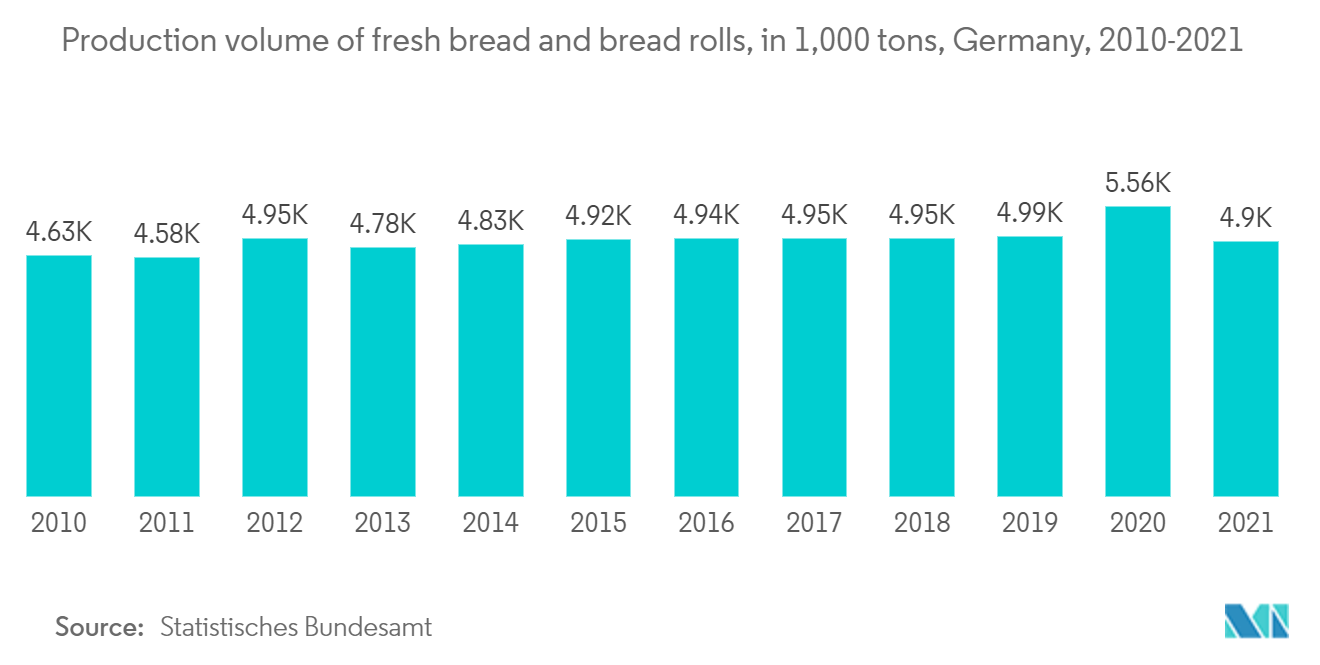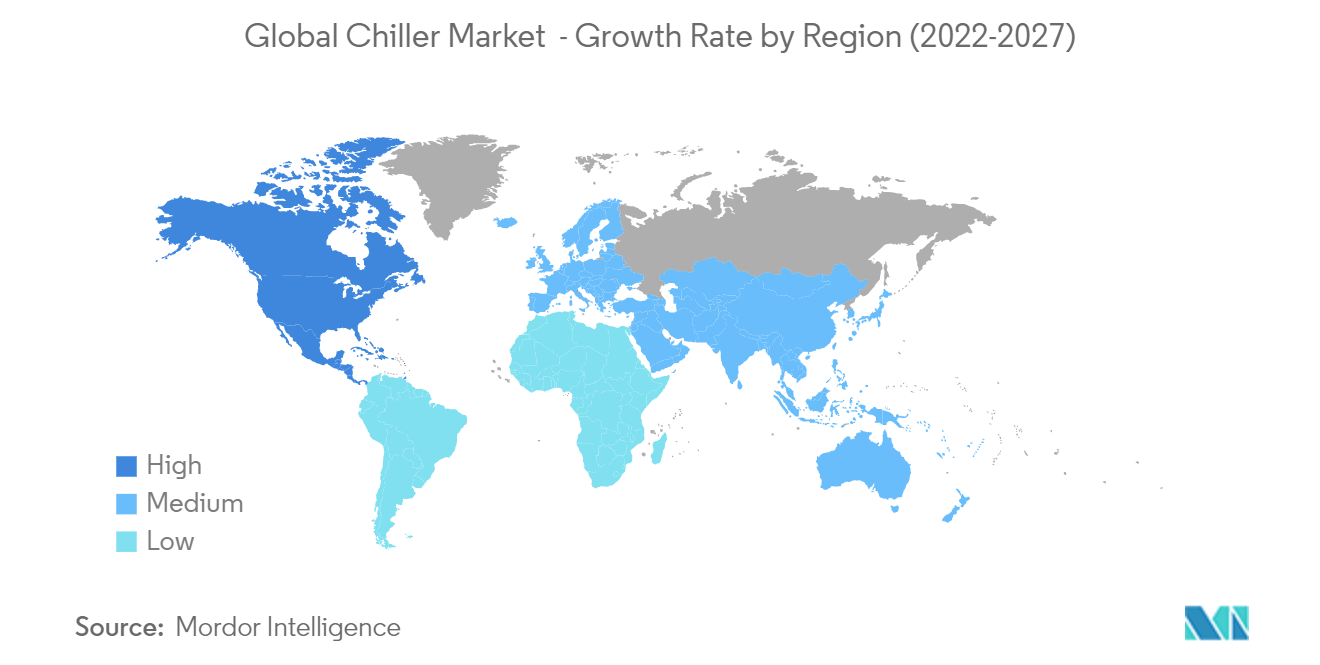Market Trends of Chiller Industry
This section covers the major market trends shaping the Chiller Market according to our research experts:
The Food & Beverage Segment will Significantly Drive the Market's Growth
- Water chillers for food processing are among the most utilized chilling systems for food and beverage producers and distributors. Food processing and food packaging applications need reliable indirect cooling equipment to maintain precise and consistent temperature control. Food processing chillers use a heat exchanger to help cool heat-producing process elements. They are used for a variety of food processing applications like cheese, meat, sauce, yogurt, ice cream, chocolate, baked items, etc.
- Globally, there has been an increase in the consumption of frozen and processed food due to several factors like convenience, increase in disposable income, busy lifestyles, etc. For instance, according to Deutsches Tiefkühlinstitut, the per capita consumption of deep-frozen food in Germany increased from 44.8 kilograms in 202 to 46.1 kilograms in 2021. Further, the Organization for Economic Co-operation and Development (OECD), estimates that the volume of cheese produced in the European Union (EU 27) would witness an uptrend from 9,938 thousand tonnes n 2018 to 11,543 thousand tonnes in 2030.
- To cater to the evolving needs of the increasing consumer base, several companies in the market are innovating advanced and comprehensive products. For instance, in March 2021, Atlas Copco extended its industrial portfolio to include process cooling equipment with the launch of the TCX 4-90A chiller range. The TCX chillers are intended for cooling water for a wide range of industrial processes and cooling applications, including Food & beverage, pharma, medical, printing, and plastics.
- Further, in March 2022, Carrier introduced the AquaForce Vision 30KAV with PUREtec refrigerant, a new line of high-performance, compact process cooling chillers with ultra-low global warming potential (GWP) refrigerant R-1234ze. The chiller line is optimized for industrial processing like food manufacturing, plastics, pharmaceuticals, chemicals, metal industries, and applications requiring ultra-reliable cooling up to -12degC.
- Additionally, in May 2022, Kaltra announced that its portfolio of high-efficient air-cooled chillers would be extended in Q3 2022, with R290 (propane) models based on the Versa platform initially launched in 2019. The heart of new Lightstream Screw II chillers is propane compressors-based design elements of Bitzer compact screws, with special safety regulations applied to the design, operation, and maintenance of flammable refrigerants like R290. These chillers target medium-low temperature refrigeration, including food & beverage, chemical, pharmaceutical, manufacturing applications, and air conditioning markets.
- Glycol chillers are witnessing an upsurge in demand in breweries and wineries. They are employed to remove the heat added during the milling, mashing, lautering, and boiling process. Modular and packed chillers are also growing in popularity in the beverage industry as they are convenient to use and easy to install.

North America to Witness Significant Growth
- The US and Canada make up the other subgroups of the North American chiller market. The construction of hospitals, offices, huge retail stores, and theatres has expanded as a result of continued economic growth and growing urbanization. The governments of North American nations support the growth of airport infrastructure and the creation of smart cities. Thus, increased tourism, smart city projects, and construction activities are driving the demand for chillers in the region's residential, commercial, and industrial sectors. The US Department of Energy (DOE) is making significant investments nationwide to raise energy efficiency standards. The goal of the DOE is to address the environmental, energy, and nuclear concerns facing the US by developing game-changing research and technology solutions.
- To meet the various demands of the customers and capture a wide market range, the companies are introducing new products in the market. For instance, in March 2022, a new low-charge inline packaged ammonia/NH3 (R717) chiller was introduced for the North American market by Frick Industrial Refrigeration, a division of Johnson Controls in the United States. A "extremely low-charge" chiller, the new Frick North America Inline Packaged Ammonia Chiller (IPAC-S) typically uses 1lb/TR, or 0.13kg/kW, according to Forry. With Frick ammonia screw compressors, the IPAC-S was created. There are 12 sizes available for these, ranging from IPAC-24 to IPAC-222, and they have chiller cooling capacities ranging from 30TR to 390TR (105.5 to 1,371.6kW).
- Furthermore, in May 2021, Welbilt, Inc., a producer of commercial foodservice equipment, is the sole distributor of roll-in blast chillers from Nuovair, the Italian company that specializes in high-quality blast chillers in the United States and Canada. Four major issues that operators experience are addressed by Nuovair technology. First off, overcooked food can be saved in a matter of seconds by abruptly stopping the cooking process to preserve flavor and quality due to the industry's greatest air-flow rate (9m3/hr) and an electronic expansion valve, which delivers up to 25% faster cooling than a manual valve.
- The data centers produce excessive heat, which presents an economic and environmental challenge. The carbon dioxide emissions from data centers are also at an all-time high which largely impacts the environment. Such heavy emissions, the need for efficient cooling, and the increasing development of data centers have driven the demand for efficient chillers in HVAC systems in data centers and have attributed to the market's growth.
- For instance, in April 2022, Meta, the parent company of Facebook, started two new data center projects in Missouri and Texas, bringing its total investment in U.S. data center construction and operations to almost USD16 billion. A USD 800 million facility in Temple, Texas, will total approximately 900,000 square feet, while another USD 800 million facility in Kansas City, Missouri, will total nearly 1 million square feet. The growing increase in the construction of data centers will significantly drive the market.
- Residential, commercial, and industrial buildings' excess heat is removed using chillers to provide air conditioning. To remove heat from the condenser and evaporators, these devices use refrigerants. The Joint Center for Housing Studies predicts that during the next ten years, baby boomers will be the main driver of construction and remodeling demand in the United States. The expansion of the country's chillers market is anticipated to be positively impacted by the nation's increasing number of construction projects. For instance, according to the United States Census Bureau, as of May 2021, the private housing authorized by building permits in May was at a seasonally adjusted annual rate of 1,681,000. The value was 34.9% above the May 2020 rate. The increase in residential units creates growth opportunities for the chiller market.


